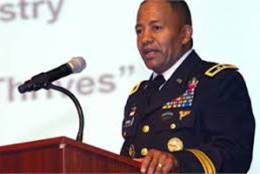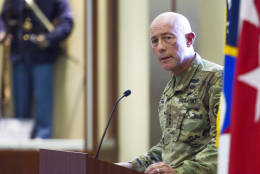Army
-
Army Chief of Staff Mark Milley joined the Army Secretary and the Navy in asking for readiness money before expanding end strength.
January 12, 2017 -
Army Secretary Eric Fanning has issued highly detailed orders to three-and-four star generals in the Army's headquarters and functional and geographic commands, telling them precisely what must be done to close 60 percent of the service’s 1,200 data centers by the end of 2018 and 75 percent by 2025.
January 10, 2017 -
The Pentagon said Tuesday that it expects to reach final decisions by July on each of the more than 17,000 cases in which soldiers were paid large bonuses to re-enlist during the heights of the wars in Iraq and Afghanistan only to be told years later that they must give the money back.
January 04, 2017 -
Viola's nomination was out of the blue, but experts say that might work to his advantage. Outsiders can create an opportunity for change through new perspectives.
December 20, 2016 -
The Army says it’s becoming the first of the military services to launch a digital service “outpost” and wants a dedicated team of technology experts from outside the government to tackle its own problems.
December 19, 2016 -
Lt. Gen. Bob Ferrell, the Army’s chief information officer/G6, said there are several parallel initiatives like data center consolidation and network consolidation to reach the end goal of having a modernized IT infrastructure and end-user services.
December 16, 2016 -
The Pentagon said Wednesday that it expects to permanently stop collection procedures for the vast majority of National Guard soldiers who, according to various audits, got bonuses they weren’t technically entitled to between 2004 and 2011.
December 08, 2016 -
The Defense Department has taken a lot of heat in recent years from industry critics who charge its procurement officials have been putting too much weight on low prices and not enough on quality.
December 06, 2016 -
Under a $2 million contract, Synack Government will use ethical hackers for penetration testing of IRS cybersecurity systems.
November 28, 2016 -
The Defense Department's $38.5 billion IT budget in the fiscal 2017 requests is being driven by three major trends contractors should be aware of: cybersecurity, cloud and analytics.
November 24, 2016 -
Army Secretary Eric Fanning warns against bumping up force size without proper funding.
November 23, 2016 -
The Defense Department undertook a significant expansion of its new crowdsourced approach to cybersecurity Monday, opening its “Hack the Pentagon” challenge to literally anyone and providing them a legal route to report any security holes they find.
November 22, 2016 -
The Army Reserve’s new leader says it’s time for a fresh look at the map so that his component of the Army can make the most of its ability to harness the skills its citizen-soldiers get from their civilian jobs.
November 17, 2016 -
Welcome to the #FedFeed, a daily collection of federal ephemera gathered from social media and presented for your enjoyment.
November 16, 2016 -
The Army will call on cyber amateurs and experts to try to break into the service's personnel and recruiting sites.
November 15, 2016















